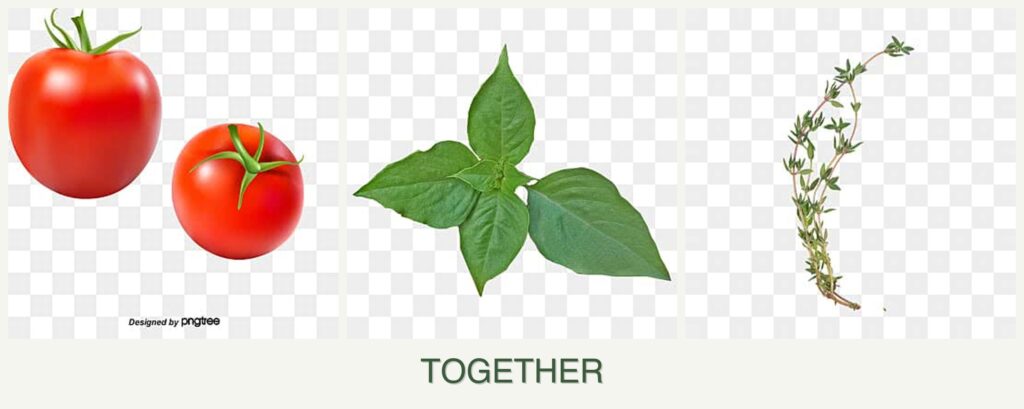
Can you plant tomatoes, basil and thyme together?
Can You Plant Tomatoes, Basil, and Thyme Together?
Gardening enthusiasts often explore companion planting to enhance their garden’s productivity and health. Tomatoes, basil, and thyme are popular choices, and understanding their compatibility can lead to a thriving vegetable and herb garden. This article will guide you through the benefits, challenges, and best practices of growing these plants together.
Compatibility Analysis
Yes, you can plant tomatoes, basil, and thyme together. These plants complement each other well due to their similar growth requirements and the benefits they offer each other. Tomatoes thrive in full sun and require well-drained soil, conditions that basil and thyme also prefer. Basil is known to repel pests like aphids and tomato hornworms, while thyme can deter cabbage worms. Both herbs can enhance the flavor of tomatoes and contribute to a healthier garden ecosystem.
Key Factors for Compatibility
- Growth Requirements: All three plants need full sun and well-drained soil.
- Pest Control: Basil and thyme offer natural pest-repelling properties.
- Nutrient Needs: They share similar nutrient requirements, reducing competition.
- Spacing: Proper spacing ensures that each plant has enough room to grow without competing for resources.
Growing Requirements Comparison Table
| Plant | Sunlight Needs | Water Requirements | Soil pH & Type | Hardiness Zones | Spacing | Growth Habit |
|---|---|---|---|---|---|---|
| Tomato | Full Sun | Moderate | 6.0–6.8, Loamy | 10–11 | 18–24 in | Upright, 3–6 ft tall |
| Basil | Full Sun | Moderate | 6.0–7.5, Loamy | 10–11 | 12–18 in | Bushy, 1–2 ft tall |
| Thyme | Full Sun | Low | 6.0–8.0, Sandy | 5–9 | 12 in | Low, Spreading |
Benefits of Planting Together
- Pest Repellent Properties: Basil deters mosquitoes and flies, while thyme repels cabbage worms.
- Improved Flavor: Basil is believed to enhance the flavor of tomatoes.
- Space Efficiency: Their different growth habits allow for efficient use of garden space.
- Soil Health: Companion planting can improve soil structure and health.
- Pollinator Attraction: Basil and thyme attract pollinators, which can increase tomato yields.
Potential Challenges
Despite their compatibility, some challenges may arise:
- Resource Competition: Ensure adequate spacing to prevent competition for sunlight and nutrients.
- Watering Needs: Thyme prefers drier conditions, so careful watering is essential.
- Disease Susceptibility: Monitor for common diseases like blight in tomatoes.
- Harvesting Considerations: Stagger harvests to prevent damage to neighboring plants.
Solutions
- Spacing: Maintain recommended distances to reduce competition.
- Water Management: Use drip irrigation to cater to different watering needs.
- Regular Monitoring: Check for pests and diseases regularly.
Planting Tips & Best Practices
- Optimal Spacing: Plant tomatoes 18–24 inches apart, basil 12–18 inches, and thyme 12 inches.
- Timing: Plant after the last frost when the soil has warmed.
- Container vs. Garden Bed: All three can thrive in containers with good drainage.
- Soil Preparation: Use a loamy, well-drained soil enriched with organic matter.
- Additional Companions: Consider planting marigolds for added pest control.
FAQ Section
Can you plant tomatoes and basil in the same pot?
Yes, as long as the pot is large enough to accommodate their root systems.
How far apart should tomatoes, basil, and thyme be planted?
Tomatoes should be 18–24 inches apart, basil 12–18 inches, and thyme 12 inches.
Do tomatoes and basil need the same amount of water?
Yes, both prefer moderate watering, but thyme requires less frequent watering.
What should not be planted with tomatoes, basil, and thyme?
Avoid planting tomatoes with brassicas and fennel, as they can inhibit growth.
Will basil affect the taste of tomatoes?
Basil is believed to enhance the flavor of tomatoes when grown together.
When is the best time to plant tomatoes, basil, and thyme together?
Plant them after the last frost in spring, when the soil is warm.
By understanding the compatibility and requirements of tomatoes, basil, and thyme, you can create a harmonious and productive garden space. Happy gardening!



Leave a Reply